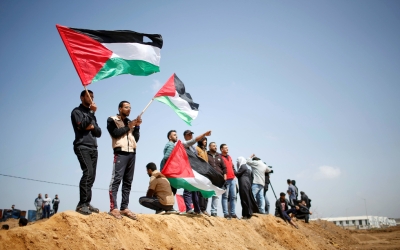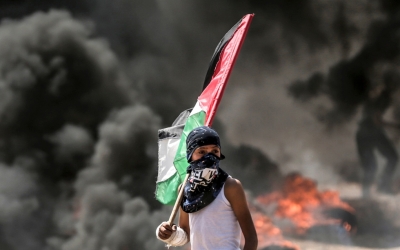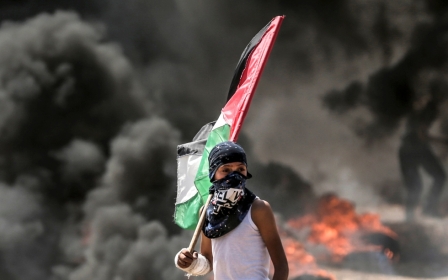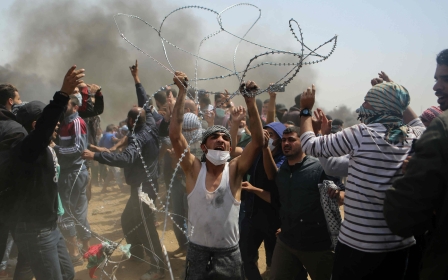Marching to a better future? Gaza factions hope protest pause will rejuvenate movement

For 36 weeks, Gaza’s Great March of Return protests have been staged uninterrupted, with Palestinians being killed by Israeli forces on a weekly basis as they call for an end to the siege and right of return.
But now the movement has been put on ice, with the High Commission for the March of Return and Breaking the Siege deciding this week to suspend the protests for three months. From then on, they will be held monthly.
The move has raised several questions about the causes and motives behind the decision.
Various Palestinian factions – except the Fatah movement – are represented in the High Commission, and for weeks they have been deliberating over how best to revitalise a movement that has seen dwindling representation.
In a majority vote, the body decided to suspend protests along the Gaza Strip’s frontier with Israel from 3 January until 30 March – the movement’s two-year anniversary and Land Day, a date of significance for Palestinian resistance.
New MEE newsletter: Jerusalem Dispatch
Sign up to get the latest insights and analysis on Israel-Palestine, alongside Turkey Unpacked and other MEE newsletters
Yusri Darwish, a commission member, justified this decision by saying that it came "according to estimates based on the interests of the Palestinian people and taking into account its circumstances".
“This time will be invested in forming a state of high readiness, mobilisation and preparation for the historic day on the anniversary of Land Day,” he said.
'This time will be invested in forming a state of high readiness, mobilisation and preparation for the historic day on the anniversary of Land Day'
- Yusri Darwish, commission member
The protests, held every Friday since March 2018, call for Israeli authorities to lift their 11-year blockade on the Gaza Strip and allow Palestinian refugees, nearly 70 percent of Gaza's residents, to return to their villages and towns in what is now Israel. Hundreds of thousands have protested in the past, but recent demonstrations have had far lower turnout.
Israel has repeatedly met the protests with deadly force, killing around 350 Palestinian protesters. Some 7,800 others have been wounded in the crackdown, according to the World Health Organisation.
Darwish said that the marches were an "epic struggle" and achieved a number of goals: most notably the revival of the right of return in the hearts of the masses, breaking the methodology of the occupation, and creating a political environment that thwarts efforts to quash Palestinians’ demands.
Another member of the commission revealed that the decision was taken based on a proposal submitted by the Popular Front for the Liberation of Palestine (PFLP) a few weeks ago, and was approved by the majority of the factions and not by consensus.
The same member, a member of a political bureau in a major faction, said on condition of anonymity that the PFLP proposal included stopping the marches immediately and restarting in 2020 as events held monthly or even on national days alone.
However, Hamas saw this as "unacceptable", the member said, adding that the faction sought to delay the decision, employ a “mediator” and seek to extract concessions from Israel in return for suspending the marches - such as easing the decade-long blockade on the coastal enclave.
The member said that after the prolonged discussion, a compromise agreement was reached that the marches be suspended but not immediately - a move approved by the majority with the "reservation" of some.
According to this same source, “Hamas and Islamic Jihad supported the decision to pare back the return marches to give them stronger momentum and reduce the number of martyrs and injuries”.
Hamas leaders and spokespeople refused to comment on the decision, pointing instead to the statement issued earlier by the High Commission.
Ibrahim al-Madhoun, a writer and political analyst close to Hamas, said that the protesters had made a lot of sacrifices, and the continuation of demonstrations for nearly two years is sufficient for a long struggle that has exhausted all its purposes. The message of the Palestinian people has been delivered with vigour and clarity, he argued.
Before the marches, he noted, the Rafah crossing with Egypt was almost completely closed and electricity supply was at its worst. Gaza suffers from international marginalisation and the sanctions of President Mahmoud Abbas, but it managed to solve, even to a small degree, many of its issues, he said.
Madhoun said that the March of Return is a tool, and there is thought about investing in it, keeping it alive and returning momentum to Palestinians.
Regarding the timing of the decision, Madhoun did not rule out a link with slated legislative elections, which some hope will help heal the fissure between Hamas and Fatah that has blighted Palestinian politics since 2006.
A shifting scene
According to Talal Abu Zarifa, representative of the Democratic Front for the Liberation of Palestine in the High Commission, participation in the marches has moved from a popular mass movement to organised rallies.
Since Hamas and other factions began providing money to the families of the martyrs and the wounded, while providing transportation to encourage public participation in the marches, the level of support has decreased to a minimum during the past few months.
Mobile loudspeakers that once roamed the streets urging people to participate have disappeared.
Those wounded in the protests suffer from a lack of good treatment in hospitals and public health facilities in Gaza, forcing them to turn to international NGOs instead, who have treated hundreds, particularly those who have lost limbs.
Abu Zarifa said that DFLP supported the decision to stage monthly marches in order to ensure that "the rallies are not distorted and the required issue is employed in security and political aspects".
"There are factors that require changing the style of struggle, and the coming three-month period is necessary in order to assess the experience of the marches, re-institutionalise the committees emanating from them, and ensure that they are distanced from the internal division and do not deviate from their national goals," he said.
The factions are proud of the "joint operations room", which they consider to be one of the most important achievements of the marches.
Writer and political analyst Hani Habib told MEE that the decision to pause the marches was supposed to be taken a few months ago, but that "hardline parties" prevented this.
For Habib, it doesn’t matter if the marches are held weekly or monthly, but "the content of the rallies must change”.
“The approach from the first day was peaceful with popular participation, and maintaining a safe distance preserves the blood of the participants,” he said. “But what happened is that parties deviated from their goals, and in the end, they achieved nothing: no facilities and no lifting of the blockade.”
The changing local and international political scene contributed to the High Committee’s decision being taken at this time, he said.
"A political movement in the Arab and regional scenes would change the nature of the confrontation and bring about a long-term truce - despite public denial - in exchange for lifting the blockade largely as a first stage, and a peace agreement, even after years," he said.
For Habib, parts of a puzzle are being moved across the board pointing to this: Hamas agreeing to an election; the faction’s openness to Egypt that saw political leader Ismail Haniyeh being allowed to tour the region; the establishment of an American field hospital in Gaza; and Hamas’ refrain from joining Islamic Jihad in clashes with Israel.
Middle East Eye delivers independent and unrivalled coverage and analysis of the Middle East, North Africa and beyond. To learn more about republishing this content and the associated fees, please fill out this form. More about MEE can be found here.






